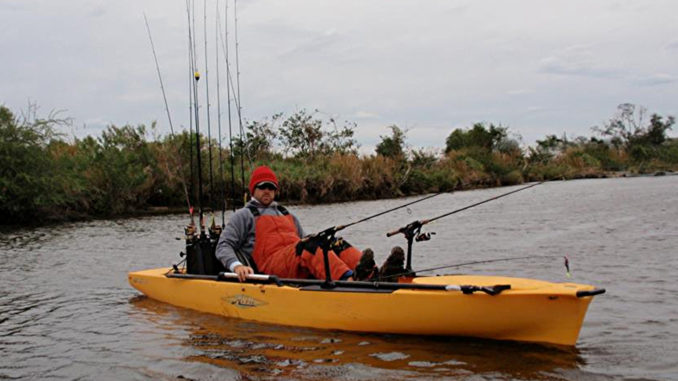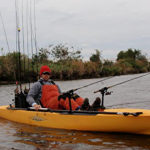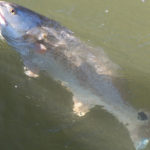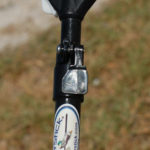
Kayaks can put you in prime redfish territory
The slight wind carried a definitive chill, and the marsh was laden with early morning fog as the sun began to peek over the horizon. Though he would welcome the warmth of the rising sun, Justin Carter’s thoughts were elsewhere.
The fishing guide and kayaking pro had just slipped his kayak across a sandbar to enter an isolated pool back in a tidal creek. He eased into a slightly crouched position, gently but forcefully skewering his anchor pole into the sand. At the far end of the pool, a dark blotch of color that resembled a massive ink blob twitched just beneath the surface.
Carter reached behind him, removing one of the dozen rods he had pre-rigged. Whipping the rod forward in a long arc, the plastic bait bounced off the hard sand bank and landed at water’s edge without a ripple. Taking up slack, he began inching the bait into the darkness when the line went heavy. Carter arched back on the medium action rod, sinking the hook into the unseen fish’s mouth.
The fish leapt from the pack as the school broke to the right, and Carter (843-725-8784) methodically fought it to the side of the boat. Grinning from ear-to-ear in the rising light, he removed the hook and laid the fish across his measuring board, noting the tail nearly brushed the 23-inch mark, then gently laid the fish in the water and made ready for his next cast.
Nothing speaks of cold-water inshore fishing more profoundly than sneaking up on a tightly packed pod of redfish and attempting to pick them off one by one. Unlike other coastal species, redfish that live at the edge of the grass in the summer are still around waiting to get back into the vegetation as the calendar flips from December to January.
“I saw a tagging study on redfish by the SCDNR,” Carter said. “One of the conclusions was that until they mature and head out into the ocean, most redfish rarely range more than a half-mile throughout their juvenile life. That means those same places where you find redfish in the spring, summer and fall will be the same places you’ll find them in the winter.”
According to Carter, one big difference he has found during his winter forays is that redfish don’t range into deep water holes, spending even more time in shallower water.
“Two reasons,” he said. “First is, all the bait is gone, and dolphins that normally feed on mullet or menhaden are now feeding on redfish. The other reason for them to stay in ultra-shallow water is a dark, shallow, muddy bottom will be warmer than the surrounding area.”
Redfish holding tight in hard-to-reach shallow water keep out of harm’s way from dolphins, but also most anglers. Carter said this is an area where kayak anglers have an advantage.
“Most boaters may find a school of reds, but they’ve been picked on and beaten down so much they’re ultra spooky, or if you do find a willing school, it won’t be long before another boat tries to cut in,” he said.
Because tides are not as severe in the winter as the summer, Carter looks for mid-tide flats — especially those with oyster mounds or sandbars between them and the main creek — to hold more fish, Using his one-man kayak, once he locates fish, he usually has them to himself and his guide parties.
“Another mistake anglers make is they fish too fast,” he said. “I use plastic baits that have a lot of action without having to move them, something like a Z-man Streak or PaddlerZ, and I always use the scented baits or at least add something like Pro-Cure because scent plays a big part in how redfish feed when it’s cold.”
Carter explains that mud flats are devoid of active life, so anything that moves, moves very slowly along the bottom. Fast-twitching a jerkbait or topwater lure may work in warmer weather, but it tends to spook fish in the winter.
Like poling a flats boat, Carter extolls his ability to stand and fish from his kayak as another key to success. He said it’s a balance of stealth and the ability to see where he’s casting that makes a difference.
Because in his kayak he’s pedaling instead of paddling, he relies heavily on an anchor pole to keep him staked in position, and he uses it to pole his kayak when the fish adjust. When he came across a hybrid product made in the Lowcountry a few years ago, he found the best of both worlds.
The company is called SuperStick (www.thesuperstick.com), based on Pawley’s Island, and makes two sizes of adjustable push poles. The smaller pole is a 6-12, adjustable from six to 12 feet, making it ideal for kayak anglers, and it doubles as a stake-out pole.
“Yea, it’s cold,” said Carter, “but those days when I can get out on a mud flat with no one else around and have a whole school of 100 fish to myself. What more could you want.”







Be the first to comment